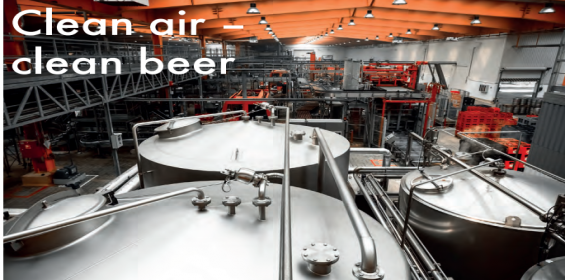Clean air-clean beer
Published: 10 June, 2020
Compressed air has critical roles to play in brewing operations but poses a major threat if it becomes contaminated. PWE reports
According to consultancy firm BDO, Britain’s food and beverage sector – of which breweries form an important part – accounts for 19% of this country’s total manufacturing. Sadly, despite generating a combined annual turnover of £97.3 billion, food and drink manufacturers and processors don’t always see their high productivity reflected in large profits. One key issue that lowers their profitability is product recalls due to contamination.
Recalling and disposing of contaminated stock is an expensive exercise whose costs may be compounded by reputational damage, compensation claims and loss of sales.
Contaminants can make products unfit for consumption by spoiling their taste, appearance and colour, reducing their shelf life and compromising their hygiene. In a sector where the health of consumers and employees is protected by tight legislation and controls, this is a serious problem.
Best compressed air practice
Compressed air has many opportunities to come into contact with beer, other beverages and food products during their manufacture and processing, so it must be kept contaminant-free. Brewers use it, for example, to power machinery used in bottling, canning and kegging. There are various air-powered systems which handle, move and cool the beer, apply labels and secondary packaging, and help in the cleaning of brewery equipment. In processes like fermentation and aeration, there is particularly close contact between compressed air and the product.
Food and drink companies should have Hazard Analysis and Critical Control Points (HACCP) plans in place which include measures to avoid contamination of compressed air. Specific guidance can be found in the publication ‘BCAS Food Grade Compressed Air Best Practice Guideline 102’.
This sets out a voluntary code of practice agreed by the British Compressed Air Society (BCAS) and British Retail Consortium (BRC). It advises on the type of compressed air equipment to use and how it should be installed, maintained and audited.
Recommendations on levels of air purity needed to minimise contamination risks from dirt, water, microorganisms and oil are also stated in the code. In addition, compressed air users are referred to international standard ISO 8573-1: 2010, which covers a range of contaminants and air purity classifications.
Contaminants and their sources
Contaminants in compressed air come from three main sources: the atmosphere, the compressor and the pipework through which compressed air is received and distributed.
They may be present in three interacting forms:
Solid – dust and microbes are drawn in from the atmosphere, while particles of various materials are released by abrasion or corrosion of the system’s components
Liquid – along with compressor lubricants and coolants, the liquid contaminants include atmospheric water pulled into the system or condensing from vapour within it
Gaseous – lubricants, coolants and water may all be vaporised
Oil removal
Oil contamination is especially unwelcome in brewing, as it kills yeast and adversely affects the beer’s frothing characteristics. Oil is present as hydrocarbon vapour in the air all around us, which we breathe and which we feed into our compressed air systems. Atmospheric hydrocarbons come from burning fossil fuels – in vehicle engines, for instance – and from evaporation of substances like paints and solvents.
Oil levels in the atmosphere may be very low, but once the air is taken into the system and compressed they become much more concentrated. The same can be said for water vapour and anything else suspended in the ambient air. It means that even if you use an oilfree compressor, you will need purification systems to remove oil and other contaminants from the compressed air it produces. Or to put it another way, with the right purification system you can use an oil-flooded compressor to supply oil-free compressed air.
Most industrial screw compressors use oil for lubrication and cooling. Mark Whitmore, general manager at BOGE Compressors, says that BOGE offers a wide range of both oilflooded and oil-free compressors, giving buyers a choice of approaches. He explains: “Oil and other hydrocarbons in the compressed air they produce can be turned into carbon dioxide and water by BOGE oil converters, branded as ‘converter bluekat’. In this way, Class O oil-free compressed air – complying with standard ISO 8573-1 – can be delivered without the need for an oil-free compressor.”
Whitmore adds that by combining BOGE oilflooded compressors and oil converters it is more affordable than buying and operating oilfree compressors or conventional treatment systems: “What’s more, it provides a reliably pure compressed air supply, regardless of the intake air quality. A further bonus is that there is no need to dispose of a contaminated condensate.”
A complete cleaning system
Oil converters may be supplemented with some or all of the following treatment methods to create a complete system:
Water separators – to remove bulk quantities of condensed water and liquid oil
Coalescing filters – to extract water or oil which has formed an aerosol of small droplets
Drying systems – to reduce air humidity by use of refrigeration, pressure-over-generation, membrane or adsorption (desiccant) dryers
Dust removal filters – to capture dry particulates and other solid materials
Sterile air filters – to ensure absolute removal of any remaining particles and microbes
Routine maintenance – to clean and sterilise all piping between the sterile filter and the application
For brewers, like anyone in the food and beverage sector, protecting consumer and employee health is paramount. Further incentives for using compressed air with care are provided by the wider financial considerations around contamination. Aside from their effects on people, products and business, contaminants can also damage expensive machinery. With the right specification and advice, compressed air systems run more economically, effectively and profitably, as well as cleanly.
For further information please visit: https://uk.boge.com/en







